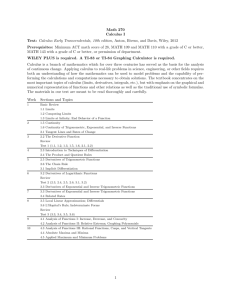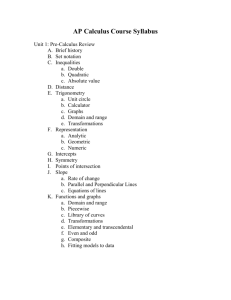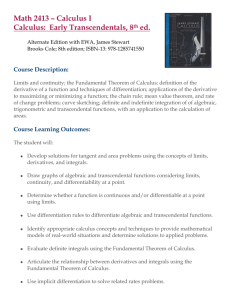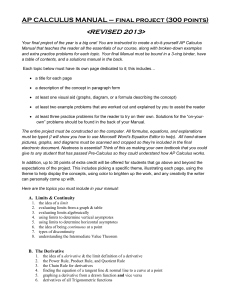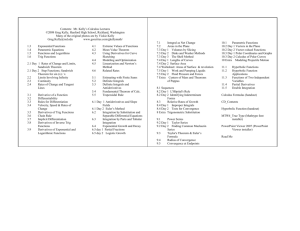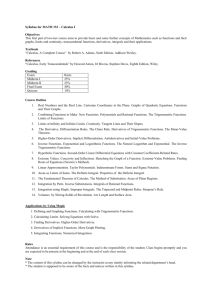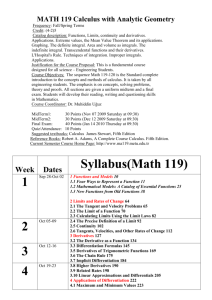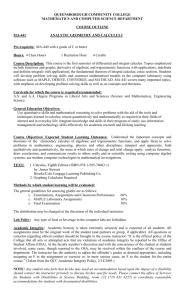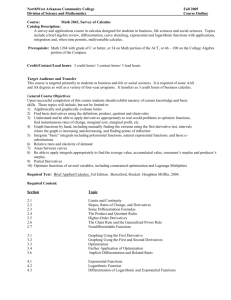MATH 2413 Calculus 1
advertisement
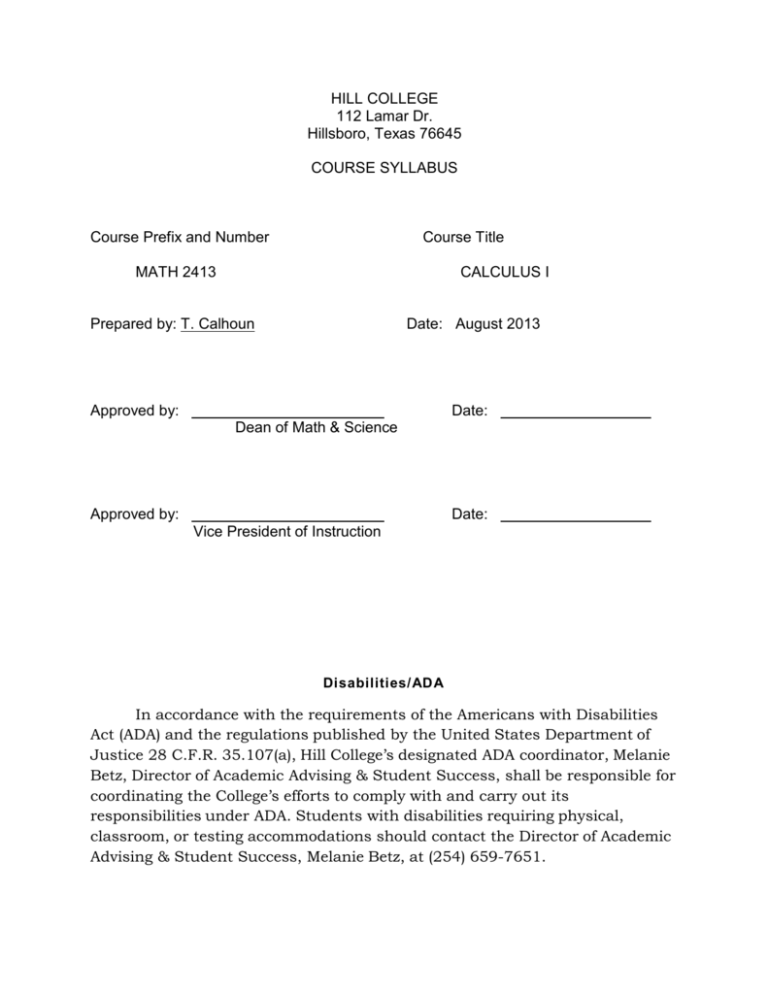
HILL COLLEGE 112 Lamar Dr. Hillsboro, Texas 76645 COURSE SYLLABUS Course Prefix and Number Course Title MATH 2413 CALCULUS I Prepared by: T. Calhoun Date: August 2013 Approved by: Date: Dean of Math & Science Approved by: Date: Vice President of Instruction Di sabi l i ti es/ AD A In accordance with the requirements of the Americans with Disabilities Act (ADA) and the regulations published by the United States Department of Justice 28 C.F.R. 35.107(a), Hill College’s designated ADA coordinator, Melanie Betz, Director of Academic Advising & Student Success, shall be responsible for coordinating the College’s efforts to comply with and carry out its responsibilities under ADA. Students with disabilities requiring physical, classroom, or testing accommodations should contact the Director of Academic Advising & Student Success, Melanie Betz, at (254) 659-7651. Course Description: MATH 2413 Calculus 1 Limits and continuity; the Fundamental Theorem of Calculus; definition of the derivative of a function and techniques of differentiation; applications of the derivative to maximizing or minimizing a function; the chain rule, mean value theorem, and rate of change problems; curve sketching; definite and indefinite integration of algebraic, trigonometric, and transcendental functions, with an application to calculation of areas. Lecture Hours: 3 Lab. Hours: 3 Semester Credit Hours: 4 Prerequisites: High school algebra, trigonometry, and geometry or approval of instructor. Introduction and Purpose: This course is meant both as a terminal math course and to prepare students for more advanced topics in mathematics. Instructional Materials: Textbooks: Calculus: Early Transcendentals with MyMathLab. Brigss Cochran. 1st edit. Pearson, 2011. Supplies: Pencils, paper, and graphing calculator. Objectives: At the completion of this course the student should be able to: 1. Develop solutions for tangent and area problems using the concepts of limits, derivatives, and integrals. 2. Draw graphs of algebraic and transcendental functions considering limits, continuity, and differentiability at a point. 3. Determine whether a function is continuous and/or differentiable at a point using limits. 4. Use differentiation rules to differentiate algebraic and transcendental functions. 5. Identify appropriate calculus concepts and techniques to provide mathematical models of real-world situations and determine solutions to applied problems. 6. Evaluate definite integrals using the Fundamental Theorem of Calculus. 7. Articulate the relationship between derivatives and integrals using the Fundamental Theorem of Calculus. The students' success in completing these objectives will be measured using a set of examinations and assignments described in detail under the section of this syllabus headed Method of Evaluation. Methods of Instruction: This course will be taught face-to-face and by various distance learning delivery methods. Audio-visual materials and computer-based technology will be used when appropriate. Students will be shown how to use a calculator where appropriate. Methods of Evaluation: A series of three or more major exams and homework assignments will be given during the semester; these will make up 75% of the student's final grade. The comprehensive final will count 25%. Letter grades for the course will be based on the following percentages: 90 - 100% A 80 - 89% B 70 - 79% C 60 - 69% D Below 60% F Class policies: Regular attendance at all class meetings is expected. Disruptions in class will not be tolerated. Topic Outline: FUNCTIONS 1.1 Review of Functions 1.2 Representing Functions 1.3 Inverse, Exponential, and Logarithmic Functions 1.4 Trigonometric Functions and Their Inverses LIMITS 2.1 The Idea of Limits 2.2 Definitions of Limits 2.3 Techniques for Computing Limits 2.4 Infinite Limits 2.5 Limits at Infinity 2.6 Continuity 2.7 Precise Definitions of Limits DERIVATIVES 3.1 Introducing the Derivative 3.2 Rules of Differentiation 3.3 The Product and Quotient Rules 3.4 Derivatives of Trigonometric 3.5 Functions Derivatives as Rates of Change 3.6 The Chain Rule 3.7 Implicit Differentiation 3.8 Derivatives of Logarithmic and Exponential Functions 3.9 Derivatives of Inverse Trigonometric Functions 3.10 Related Rates APPLICATIONS OF THE DERIVATIVE 4.1 Maxima and Minima 4.2 What Derivatives Tell Us 4.3 Graphing Functions 4.4 Optimization Problems 4.5 Linear Approximation and Differentials 4.6 Mean Value Theorem 4.7 L’Hôpital’s Rule 4.8 Antiderivatives ITEGRATION 5.1 Approximating Areas under Curves 5.2 Definite Integrals 5.3 Fundamental Theorem of Calculus 5.4 Working with Integrals 5.5 Substitution Rule APPLICATIONS OF INTEGRATION 6.1 Velocity and Net Change 6.2 Regions between Curves 6.3 Volume by Slicing 6.4 Volume by Shells 6.5 Length of Curves 6.6 Physical Applications 6.7 Logarithmic and exponential functions revisited 6.8 Exponential models BIBLIOGRAPHY Briggs, Cochran; Calculus, Early Transcendentals. Pearson 1st edition 2011

